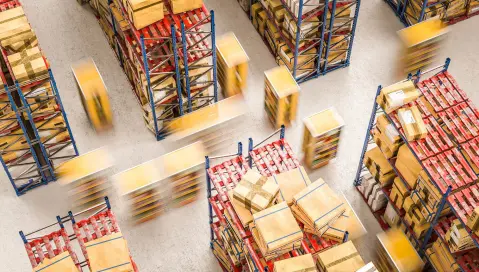Uitgelicht in deze blog
5 Tips for a Stronger Supply Chain
5 Tips for a Stronger Supply Chain
22 Nov 2021
Ken Weygand
The issues and disruptions across the global supply chain have dominated the news cycle of late. If you are a consumer goods importer, the ability to get your orders on time is crucial to your profit margins. Unless you can afford to pay for private shipping or have your goods flown in, your business is feeling the crunch. For years, many distributors worked on a just-in-time supply model, in which their enterprises received goods as close to the due date as possible.
That model won’t work long-term, however, as it does not take disruptions into consideration. If there is any kind of supply or demand change, everything stops. The fault with this strategy was evident after the pandemic hit in 2020. For example, think about the massive shortages that occurred in early 2020—everything from meat to surgical masks to toilet paper disappeared from store shelves. When supplies did arrive, it was in limited quantities until the manufacturers were able to ramp up their production efforts again. We are still seeing shortages today, with the accompanying price hike.
What was the result? If the pandemic taught us anything, it was that companies that wish to succeed in the face of rapid-fire change and possible disruption need to be agile; they need to diversify; and they need to have a strong contingency planning strategy in place.
In this post, we’ll discuss several tactics that your consumer goods distribution company can take to stay ahead of supply chain disruptions.
1. Implement Demand Planning
If you are unfamiliar with the concept of demand planning, it’s a process that allows businesses to meet customer demand and minimize excess inventory. Ideally, demand planning helps mitigate the impact of supply chain disruption. Accurate demand planning amplifies profitability and increases customer satisfaction, all while augmenting efficiency throughout your business.
You can do this by analyzing data such as historical sales, seasonal trends, and consumer trends. It requires communication and the concerted efforts of your entire organization. Striking the right balance between correct inventory levels and customer demand is complicated. Considering the current chaos of the global supply chain, it can be almost impossible for business owners that don’t have the right tools in place.
An industry-specific ERP with built-in demand planning lets you adjust purchasing decisions in the face of supply chain disruptions. A distribution ERP synchronizes sales, supply, and purchasing functions, so you get precise forecasting. If you still aren’t sold, reflect on this: to get accurate inventory levels you need to track hundreds of factors, like geographical sales data; lead times; seasonal and historical customer data; to name a few. Now imagine trying to do that using spreadsheets.
The fact is, if you want to remain agile in today’s volatile market, a distribution ERP is a must-have.
2. Diversify Suppliers
We know that you have spent years building relationships with your suppliers. But if long lead times or disruptions are causing a massive backlog, it’s time to rethink those relationships. In addition, younger consumers want their purchases to reflect their values, so ethical business practices and sustainability must be top of mind when choosing your business partners.
No one could have predicted the massive impact that the pandemic would have on the global supply chain. But there will always be disruptions. The trick is to have alternate suppliers in line as a means for recovery strategy.
Supplier diversification is one of the most effective ways to mitigate risk. The process involves doing research and finding alternate suppliers. You may want to focus on reshoring or nearshoring production.
For example, if your current supplier is in China, you might find one that operates out of Central America. Leveraging suppliers from different regions may raise production costs but having a distribution ERP in place will help you increase efficiencies and control costs in other aspects of your enterprise. And you’ll be better prepared if future disruptions arise.
3. Invest in Your Employees
You know that operating an efficient, streamlined consumer goods distribution business is complex. You must know where everything is, all the time. Without a strong team to back you, getting that information would be impossible.
That’s why investing in your team’s success is imperative. In a study conducted by Forbes, highly engaged teams exhibit 21% greater profitability, with a 41% reduction in absences and 59% less turnover. It sounds like common sense, but how can you achieve it? By using staff development strategies.
Here are some ways to do that.
Have formal training curriculum in place, as well as on-the-job training.
Have ongoing learning and development opportunities.
Offer peer and management coaching and mentoring.
Ensure bottom-up accountability, with reward and recognition systems.
Incorporate standardized goal tracking so that employees know what is expected of them.
In addition, have all employees rotate through multiple assignments and training, so that they understand how your business’s processes work and their impact on the enterprise as a whole. Maybe you can work with your HR department and create a standardized strategy to keep your team engaged. This will boost staff satisfaction and general performance.
4. Improve Visibility
You know that if you want to compete, you need full visibility into your supply chain. You need to give your customers and your stakeholders access to valuable real-time, or near real-time, information on where all orders are. You also need to fulfill evolving customer demands, meet compliance requirements and keep up with your competitors.
The basic concept behind supply chain visibility is that data is available throughout your organization. Everyone, from the sales team to your warehouse employees, will know production schedules, order status, and order exceptions. A good ERP serves as a single source of truth for all your supply chain data. Your team will communicate more effectively, leading to improved customer experience and clear accountability all along the supply chain.
If you tried to manage all this with disparate systems and manual processes, you’d have more errors, more inaccuracies and no idea where your inventory is. However, a distribution ERP streamlines your supply chain management, so you’ll always know where your products are. An ERP does this by providing timely updates, which allow you to identify issues and respond quickly. An industry-specific ERP with warehouse management and EDI capabilities, like Aptean Distribution ERP, makes your business more agile—which is what you need to thrive.
5. Embrace Distribution ERP
The advanced tools in modern ERP systems analyze your inventory and supply chain data to derive valuable insights which can be used to forecast customer demand. This allows you to prepare for when products are not easily accessible, and you’ll avoid significant disruption to supply chain performance. In addition, you’ll strengthen your enterprise with real-time actionable insights. This enables better responsiveness and allows you to maintain business continuity in the face of disruption.
With a distribution ERP, you’ll know what's moving, how quickly, and if the patterns are changing. Armed with this data, you can discern trends, prioritize, and plan accordingly. Good ERP technology lets you control the situation before disruptions occur. You’ll reduce waste, which allows you to extend the life of existing inventory.
Aptean’s Distribution ERP has an added bonus—our profitability scorecard. You’ll be able to do a deep dive into the profitability of each customer, product and supplier. The profitability scorecard has integrated retailer compliance functionality, which allows users to track and manage chargebacks, accruals and EDI fees. Then you can leverage that data to improve decision-making and plan for risk.
Right now, you need to focus on building a business that is as future-proof as possible. Using intelligent, industry specific technology like our distribution ERP will increase resilience, streamline operations and improve your company’s agility. Aptean Distribution ERP will set you up for success now and will also help you sustain competitive advantage to accelerate business growth once the supply chain rebounds.
Want to learn more? Find out how, now.
Klaar om uw bedrijf naar een hoger niveau te tillen?
We hebben gespecialiseerde ERP-oplossingen waarmee u elke uitdaging in uw branche aankunt.



